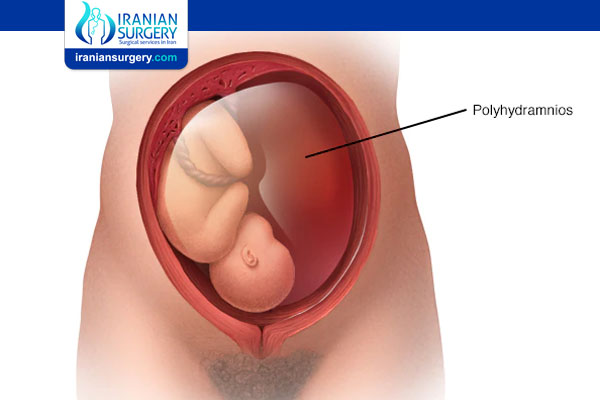Polyhydramnios
What is Polyhydramnios?
Polyhydramnios is a condition which affects the uterus of a pregnant woman. In this condition, too much amniotic fluid (the liquid that surrounds the baby in the womb) collects in the uterus. When this happens, the uterus becomes larger than normal.
Amniotic fluid has a significant role in the baby’s growth. Typically, amniotic fluid is swallowed by the baby in utero and then urinated out. This steadies the amount of fluid in the uterus.
This condition can present itself as soon as 16 weeks into the pregnancy. However, more often it will show as the pregnancy progresses into later weeks.
Before Polyhydramnios Treatment
How common is polyhydramnios?
Polyhydramnios is considered rare. This condition affects roughly 1 percent of pregnancies.
Who is affected by polyhydramnios?
Any pregnant woman can be affected by polyhydramnios. However, it is distinguished as a rare condition.
What are the symptoms of polyhydramnios?
For women experiencing a mild case of polyhydramnios, there may not be any symptoms. Women experiencing a more severe form of the condition could have these symptoms:
. Sensation of tightness in stomach
. Indigestion
. Difficulty with bowel movements (constipation)
. Producing less urine
. Enlargement of vulva
. Breathing troubles
. Swelling of leg, thigh, hip, ankle and/or foot
What causes polyhydramnios?
For most women, the cause of their polyhydramnios condition remains a mystery. Women with mild cases most likely have symptoms due to the increasing amount of fluid in their uterus. Moderate to severe polyhydramnios could be caused by the following:
. Birth defect affecting the baby’s ability to swallow
. High blood glucose levels (mother has diabetes either before or after becoming pregnant)
. Carrying identical twins with transfusion syndrome (TTTS)
. Differing blood types (mother has Rh-negative, baby has Rh-positive)
. Problem in the baby’s stomach
. Issues with the placenta
. Too much fluid in the baby
. Complications with the heart rate of the baby
. Baby develops an infection
Diagnosis and Tests
How will a doctor diagnose polyhydramnios?
A doctor will measure your stomach and determine if your uterus is too large. Typically, that means you are measuring two or more weeks ahead of your expected due date. In addition, polyhydramnios can be diagnosed if the doctor has difficulty locating the heartbeat of the baby or feeling for the baby.
Ultimately an ultrasound will be done to determine the amount of amniotic fluid.
What are the complications associated with polyhydramnios?
During polyhydramnios, the distended uterus puts pressure on other organs. This can cause pregnancy complications, especially if the condition shows itself early into the pregnancy. Other complications from a severe form of the condition include:
. Mother going into labor too early
. Baby being born too early
. Baby growing too quickly and becoming too large while in the womb
. Placenta detaching from uterus (placental abruption) before birth of baby
. Mother suffering from too much bleeding (hemorrhage) after giving birth
. Umbilical cord falling out before baby is born (umbilical cord prolapse)
. Baby laying in wrong position in the womb (fetal malposition)
. Baby being born without signs of life (stillbirth)
During Polyhydramnios Treatment
Management and Treatment
How is polyhydramnios treated?
Polyhydramnios is generally not treated if it is a mild case. Your doctor may schedule additional appointments to check on the size of the growing uterus. The baby should be born healthy and without complications.
If the size of the uterus becomes more of an issue and the condition more severe, a treatment plan can be formulated by your doctor. This plan will more than likely focus on the cause of the polyhydramnios. For example, medication can be taken to control the baby’s urine production while in the womb. Other treatments include:
. Bed rest
. Draining amniotic fluid using a large needle
. Inducing labor early
What can I do to help relieve symptoms of polyhydramnios?
If you are diagnosed with polyhydramnios, you can try to relieve the symptoms through the following ways:
. Remain calm
. Rest for longer periods of time
. Be upfront with your doctor about how you envision your labor and birth process to proceed, especially if it occurs prematurely
. Contact your doctor if you feel other symptoms occur, your belly becomes larger quickly or you are feeling fearful about the baby’s growth
. Join an online forum to speak to other women with similar issues
After Polyhydramnios Treatment
Outlook / Prognosis
What is the outlook for patients who have polyhydramnios?
For patients who have polyhydramnios, they will be advised to give birth in a hospital, rather than at home. The baby’s heartbeat will be evaluated during labor to make sure the baby is not going through too much stress. You may also pass a large amount of fluid as you give birth, which is normal during this time.
The baby’s stomach may be evaluated after birth to make sure there is nothing abnormal. Typically, the babies born to moms with polyhydramnios are healthy.
When do I call the doctor about polyhydramnios?
A doctor should be called to further evaluate your condition of polyhydramnios if your belly becomes larger in a very short amount of time. This may cause you to deliver the baby early.
Source:
. https://my.clevelandclinic.org/health/diseases/17852-polyhydramnios


